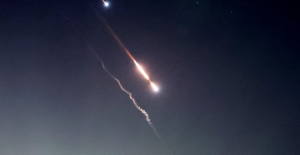Bolmande smoke stood out as a leaning, leafy trees over the färjeliknande 80 - and 90-century houses in the old barnängen property. We stood, a crowd of friends and a baby stroller out on a walk which came of itself, in Hammarby Sjöstad, and looked up into the sky. Where did it come from? On social media, it was nothing. Well, there. ”Something small damn bad right in the centre of Stockholm,” wrote a journalist with a picture, in the middle of town, the smoke towered up, pitch-black like anxiety and great concern. ”Looks to be gone at the Comment about”, someone answered. In the first pushnotisen that pops up on any of our phones, it says if a bus and an explosion.
An hour after terrorattentatet on Drottninggatan shopping street in Stockholm in april 2017 knew half of the Swedish people that it had happened, according to a survey of medievetaren the Question at the JMG. At five o'clock in the afternoon, it was 85 per cent, who knew.
spreading so quickly is that drives us into the arms of each other: we want to hear that all you care about is feeling good and try to understand the event as a group, with their families, with their friends, with the woman next to the one on the metro if it so required. ”Speculation, guesswork and rumors mixed with facts and verified information. This type of vidarekommunikation usually takes at immediately after the threats, risks, and samhällskriser become widely known”, that Question and two colleagues write in a new study, made by JMG on behalf of the MSB and published in a week.
it examines The ”content and effects of news about threats and alarms,” to quote the title, and notes that the words ”threat” and ”risk” is today used much more often in the media than ten years ago, and the ”alarm” twice as often.
It is in the media pushnotiser this can be seen most clearly: this journalism latest and perhaps most direct communication tool ever contains ”more pointed formulations and sensational information, and (...) is provisional, that is to say, unconfirmed information.”
have you examined how people react to pushnotiser, and found that those be accessed solely by an ostentatious pushnotis early in the " stage becomes the most emotionally relevant and most likely to want to talk to someone about the news. In short: most likely to spread rumors.
the Urge to verify is not spontaneous, writes Jean-Noël Kapferer in his influential book Rumors: the world's oldest nyhetsmedium (1987). He notes that the man is neither inclined or able to determine if most of the rumors she is hearing are true, and that ryktesspridningsprocessen therefore becomes both a way to disseminate information and comment on and interpret it. Rumors is the team's voice, " he summarises.
Question with several continues as it would in the next breath: ”there is A problem in this context is that the other is likely to know as little, or only slightly more, and therefore neither can contribute with more facts about what happened. Thus, there is a clear risk that early, brief and fragmentary public service announcements, such as pushnotiser of threats and risks, ultimately leading to increased rumours, guesses and misinformation.”
, persuaded to believe that its function is to be fast rather is correct, their most despised enemy. Nothing could be more topical than a critical glance on how the media use pushnotiser, in order to understand if the impair journalism and how they can improve it. You now get a deja vu experience is not wrong: last year, I wrote about the same thing, but noted with disappointment that my colleagues seem to be completely uninterested by such a review.
the Question also wanted to study the contents of the pushnotiserna, she writes in an e-mail to me, but could not. Spectacularly enough, there are not any Swedish media company that provides an archive of their published pushnotiser. It is a new kind of publications, with the consequences we do not yet fully understand or know but that partly seems to be able to be destructive, which are allowed to go up in smoke after they have been made, impossible to systematically call into question or review. It is irresponsible of issuance, hidden in the middle of the daylight.
turned out to be just an accident, which we became aware, partly through the new pushnotiser. But the troubling news is many, and such follow-up will not always. The Swedish editors who take their journalism seriously reasonably today to reflect on how their pushnotiser be made available. There are no longer any excuses.
Read more the chronicles of Jack Werner here. For example, this: ”We need to stop playing human lågvattenmärken against each other”.

 Torrential rains in Dubai: “The event is so intense that we cannot find analogues in our databases”
Torrential rains in Dubai: “The event is so intense that we cannot find analogues in our databases” Rishi Sunak wants a tobacco-free UK
Rishi Sunak wants a tobacco-free UK In Africa, the number of millionaires will boom over the next ten years
In Africa, the number of millionaires will boom over the next ten years Iran's attack on Israel: these false, misleading images spreading on social networks
Iran's attack on Israel: these false, misleading images spreading on social networks New generation mosquito nets prove much more effective against malaria
New generation mosquito nets prove much more effective against malaria Covid-19: everything you need to know about the new vaccination campaign which is starting
Covid-19: everything you need to know about the new vaccination campaign which is starting The best laptops of the moment boast artificial intelligence
The best laptops of the moment boast artificial intelligence Amazon invests 700 million in robotizing its warehouses in Europe
Amazon invests 700 million in robotizing its warehouses in Europe Switch or signaling breakdown, operating incident or catenaries... Do you speak the language of RATP and SNCF?
Switch or signaling breakdown, operating incident or catenaries... Do you speak the language of RATP and SNCF? Transport in Île-de-France: operators are pulling out all the stops on passenger information before the Olympics
Transport in Île-de-France: operators are pulling out all the stops on passenger information before the Olympics Radio audiences: France Inter remains firmly in the lead, Europe 1 continues its rise
Radio audiences: France Inter remains firmly in the lead, Europe 1 continues its rise Russian cyberattacks pose a global “threat”, Google warns
Russian cyberattacks pose a global “threat”, Google warns A new Lennon-McCartney duo, more than 50 years after the Beatles split
A new Lennon-McCartney duo, more than 50 years after the Beatles split The Curse vs Immaculée: two thrillers but only one plot
The Curse vs Immaculée: two thrillers but only one plot Mathieu Kassovitz adapts The Beast is Dead!, the comic book about the Second World War and the Occupation by Calvo
Mathieu Kassovitz adapts The Beast is Dead!, the comic book about the Second World War and the Occupation by Calvo Goldorak 'has never lived so much as now'
Goldorak 'has never lived so much as now' Skoda Kodiaq 2024: a 'beast' plug-in hybrid SUV
Skoda Kodiaq 2024: a 'beast' plug-in hybrid SUV Tesla launches a new Model Y with 600 km of autonomy at a "more accessible price"
Tesla launches a new Model Y with 600 km of autonomy at a "more accessible price" The 10 best-selling cars in March 2024 in Spain: sales fall due to Easter
The 10 best-selling cars in March 2024 in Spain: sales fall due to Easter A private jet company buys more than 100 flying cars
A private jet company buys more than 100 flying cars This is how housing prices have changed in Spain in the last decade
This is how housing prices have changed in Spain in the last decade The home mortgage firm drops 10% in January and interest soars to 3.46%
The home mortgage firm drops 10% in January and interest soars to 3.46% The jewel of the Rocío de Nagüeles urbanization: a dream villa in Marbella
The jewel of the Rocío de Nagüeles urbanization: a dream villa in Marbella Rental prices grow by 7.3% in February: where does it go up and where does it go down?
Rental prices grow by 7.3% in February: where does it go up and where does it go down? Europeans: the schedule of debates to follow between now and June 9
Europeans: the schedule of debates to follow between now and June 9 Europeans: “In France, there is a left and there is a right,” assures Bellamy
Europeans: “In France, there is a left and there is a right,” assures Bellamy During the night of the economy, the right points out the budgetary flaws of the macronie
During the night of the economy, the right points out the budgetary flaws of the macronie Europeans: Glucksmann denounces “Emmanuel Macron’s failure” in the face of Bardella’s success
Europeans: Glucksmann denounces “Emmanuel Macron’s failure” in the face of Bardella’s success These French cities that will boycott the World Cup in Qatar
These French cities that will boycott the World Cup in Qatar Champions League: semi-final schedule revealed
Champions League: semi-final schedule revealed Serie A: AS Roma extends Daniele De Rossi
Serie A: AS Roma extends Daniele De Rossi Ligue 1: hard blow for Monaco with Golovin’s premature end to the season
Ligue 1: hard blow for Monaco with Golovin’s premature end to the season Paris 2024 Olympics: two French people deprived of the Olympic Games because of a calculation error by the international federation?
Paris 2024 Olympics: two French people deprived of the Olympic Games because of a calculation error by the international federation?


















